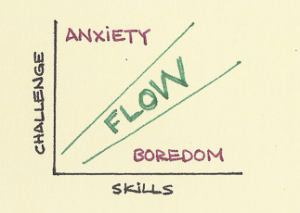What the flow is and tips for using it.
Most reinforcement experiences are structured around a lot of new information. The problem with this is it’s exhausting for your employees. How else could reinforcement experiences be structured? Is it a structure for reinforcement to switch between acclimating and assimilating the information?
What is the Perfect Reinforcement Flow?
The Czech psychologist Mihaly Csikszentmihalyi introduced ‘the flow’, which he describes as “Joy, creativity, the process of total involvement with life!”
While Csikszentmihalyi’s flow model has several aspects to it, one of the core tenets is a balance between ability and challenge.
When the challenge far exceeds an employee’s ability, it’s probably too difficult for that employee, and it quickly becomes frustrating. But when something is far too easy for an employee, the reinforcement is boring.
On the other hand, reinforcement content that's slightly too hard can be a satisfying challenge, while content that's a little bit easy can be a satisfying opportunity to coast for a few minutes.
The reinforcement flow would allow employees a balance of challenge and satisfaction.

*Mihaly Csikszentmihalyi's Flow Diagram
Feedback
To make the reinforcement course effective, employees need to be able to tell how they're doing. This is particularly important for skills development. You can recognize a good reinforcement course by the frequency and variety of feedback mechanisms.
If you use the Content, Challenge, Activity, and Feedback model, and you design a reinforcement course around structured goals, you have a lot of built-in feedback points. Always look for opportunities and ways to increase the frequency of feedback whenever possible.
Score, reinforcement progress, ranking, points, visual cues, etc. all pulled from the gaming industry. Another characteristic of Csikszentmihalyi’s flow model is knowing what you need to work on next.
Always Be Able to See the Next Goal
Sebastian Deterding uses a structured flow of goals (Deterding 2011).
The accomplishment of short-term goals is necessary to achieve the longer-term goals, which in turn roll up to accomplish overarching goals.
Your employees want to know where they need to head next and they want feedback on how they're doing while getting there.
3 Tips for the Perfect Reinforcement Flow
- If you don’t give your learners a chance to rest, they’ll take it anyway.
- Promote engagement by using structured goals and real accomplishments.
- Use frequent and multifaceted feedback to shape behavior.
